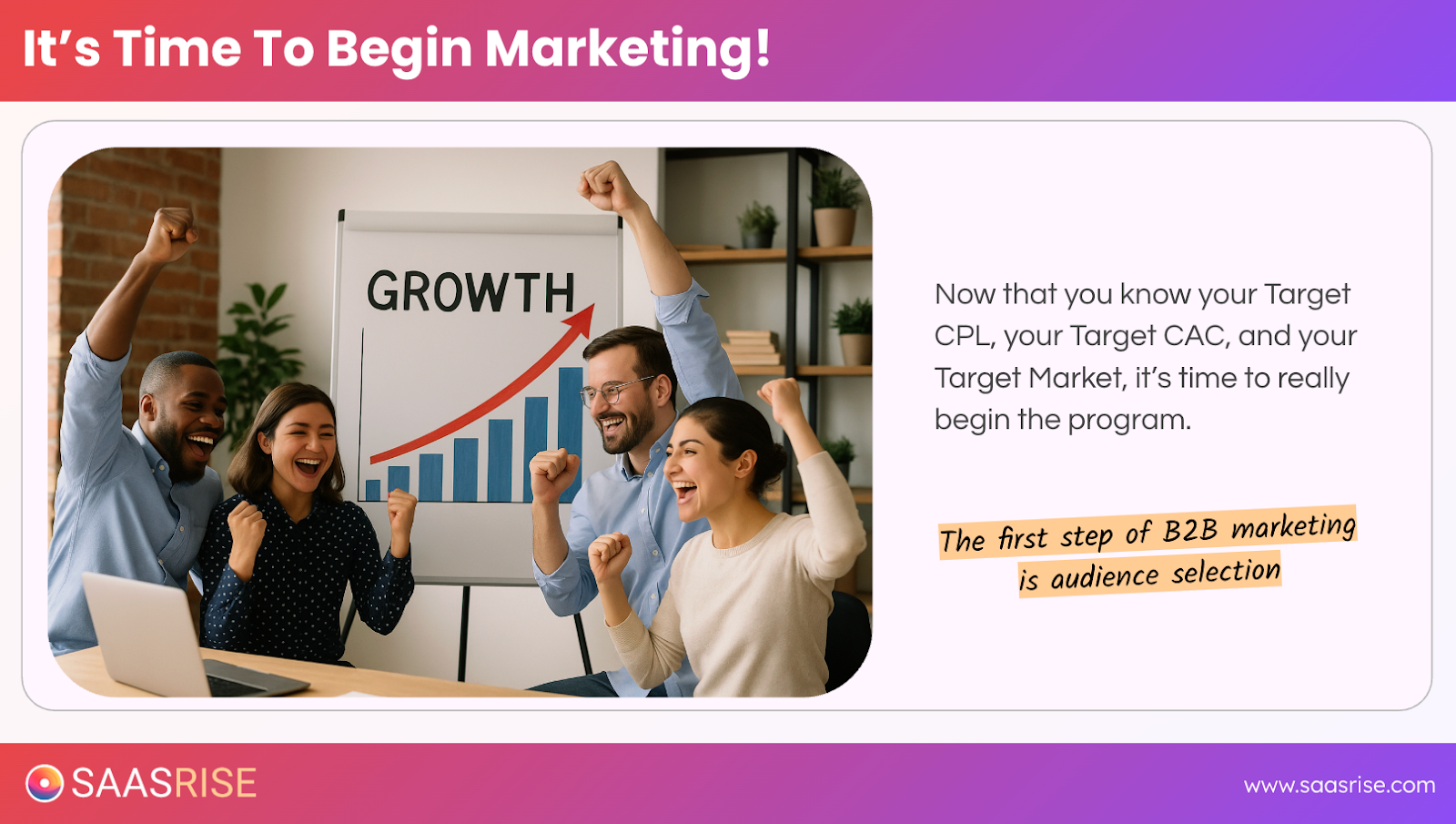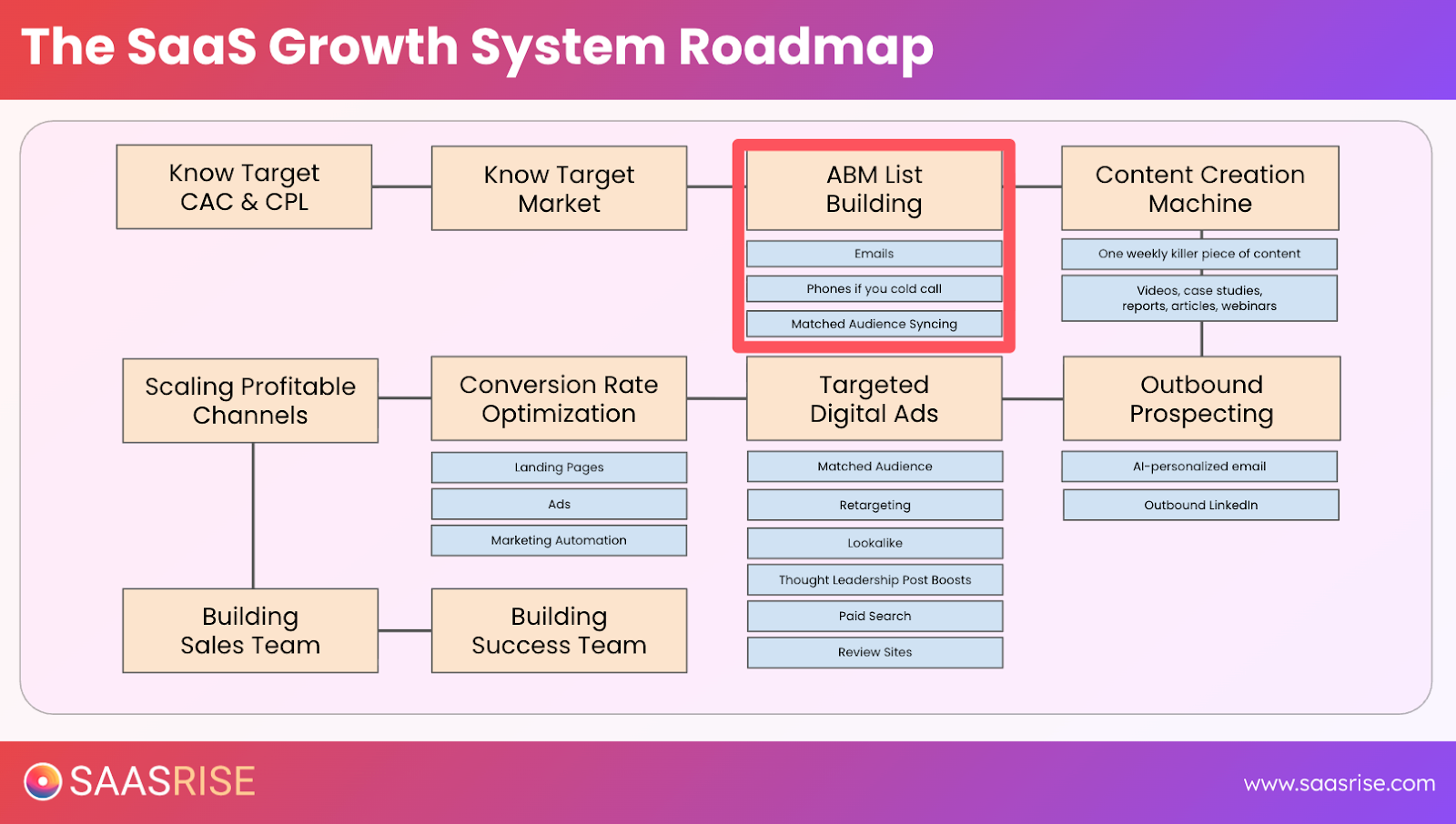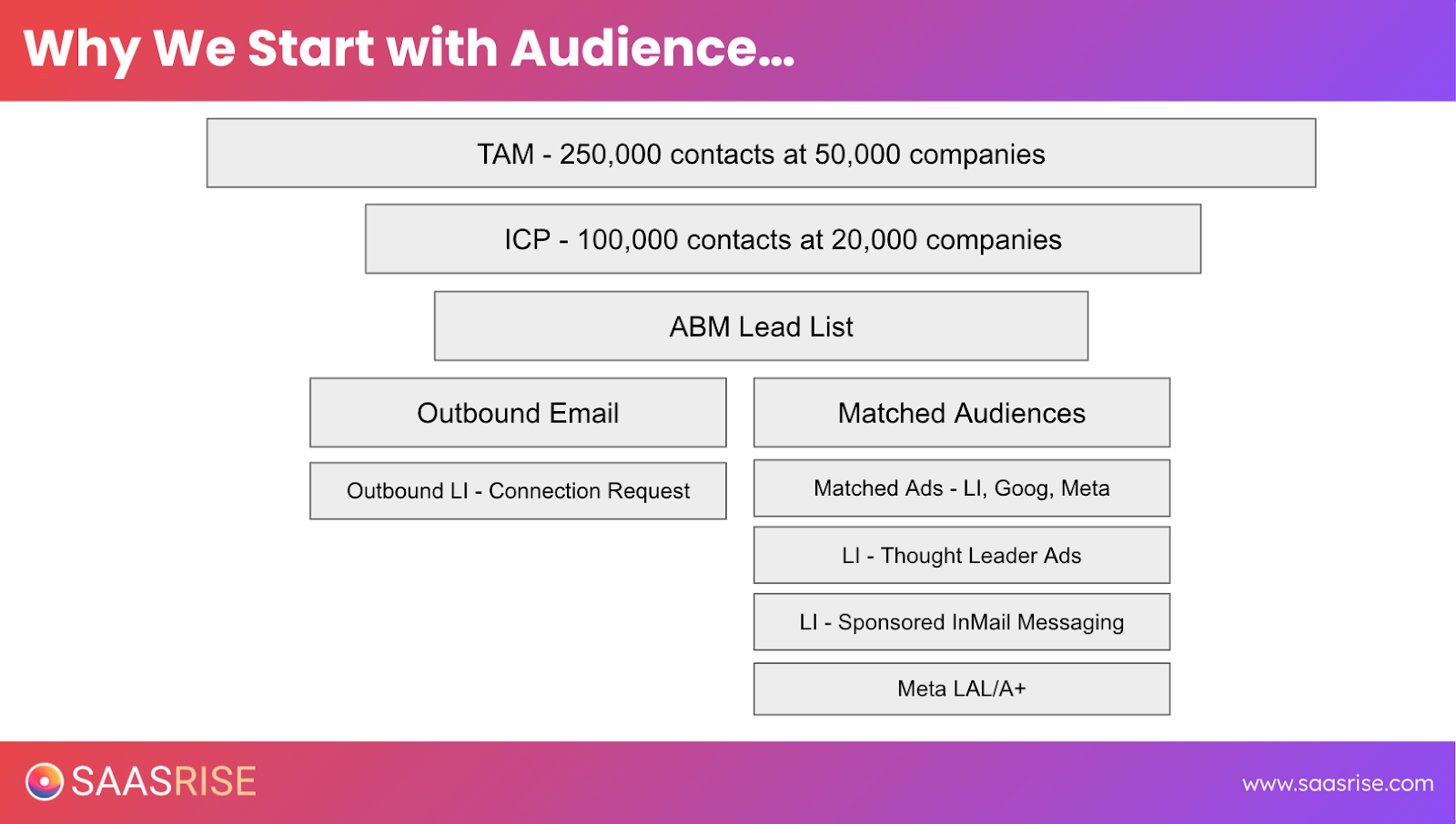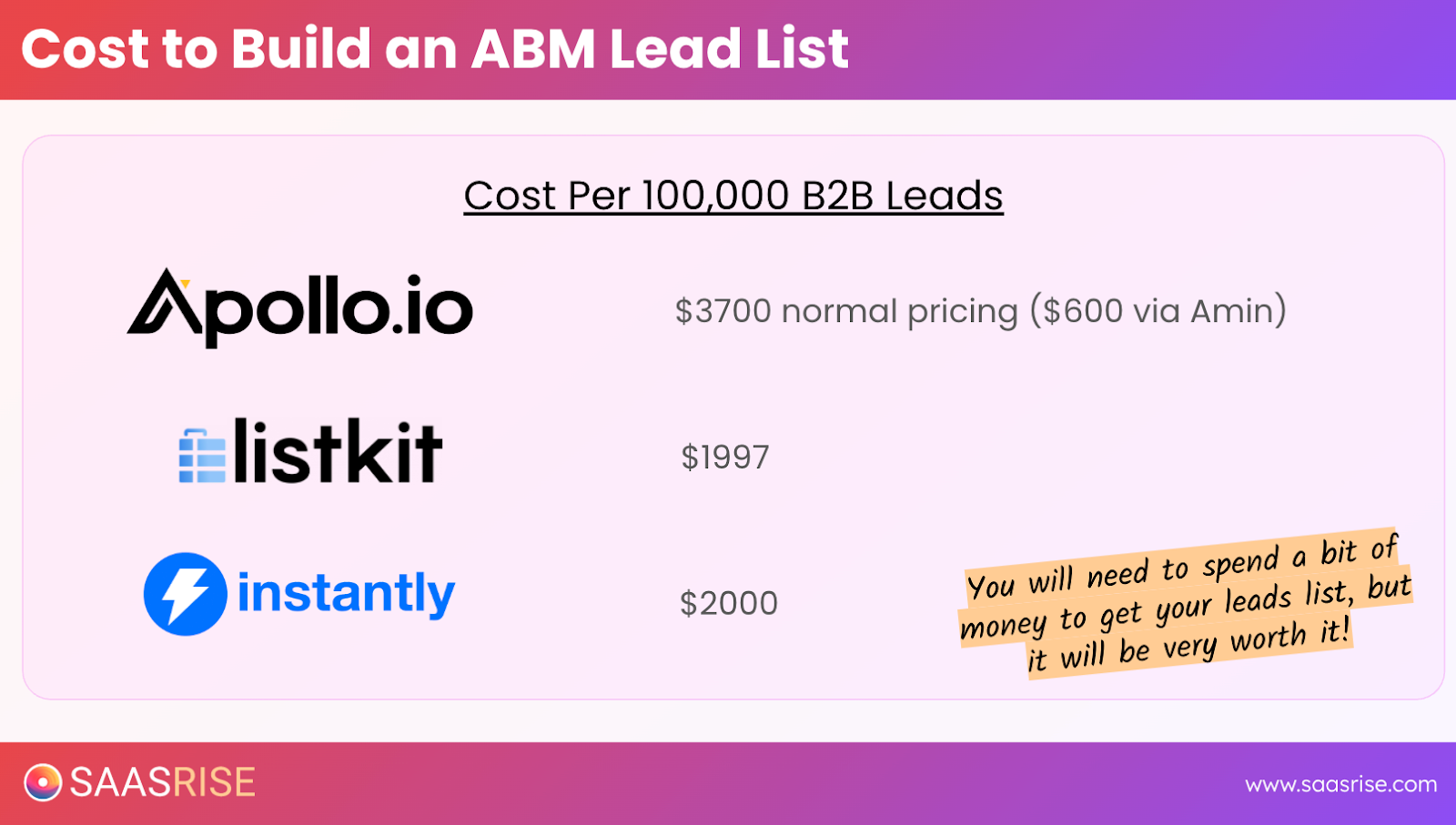
ABM Lead List Building
Every scalable B2B SaaS growth engine starts with one thing: a great list. Not a random spreadsheet. Not a dump of emails you bought in a hurry. I’m talking about a living, verified, intelligently curated dataset of the exact companies and people most likely to buy from you — your Ideal Customer Profile (ICP). That list becomes the foundation for everything else: your outbound sequences, your matched-audience ads, your SDR outreach, even the content you decide to publish.
When we launched SaasRise, we didn’t start with a big ad budget or a huge team. We started with data. We invested about $23K to build a verified, deduplicated list of ~450,000 SaaS founders and CEOs across 14 sources. That list fueled our outbound, gave us immediate matched audiences on Meta, LinkedIn, and Google, and powered our thought-leadership distribution. It’s the backbone that took us from zero to $3M+ ARR with just five people.
That’s the power of ABM lead list building.
Step 1: Know Your Numbers Before You Start
Before you build even a single list, you need to know your unit economics. If you don’t know what you can afford to spend to acquire a customer, you can’t decide how deep to go with data, ads, or outbound — and you’ll either overspend and burn cash, or underspend and stall.
Here’s the quick refresher I give every founder:
- Customer Acquisition Cost (CAC): Total sales + marketing cost divided by new customers won. As a rule of thumb, aim for CAC to be about one-sixth of your LTV.
- Lifetime Value (LTV): What a customer is worth over time. A simple way to estimate: ARPA × 12 ÷ monthly churn rate, then adjust for gross margin if you want more precision.
- Payback Window: How fast CAC comes back. For capital efficiency, ≤ 9 months is a strong target (you can stretch to 12 months if you’re well funded).
- LTV:CAC Ratio: The sanity check. A 6–8:1 ratio is the sweet spot for healthy, scalable growth.
If your payback is under 12 months and churn is under 3%, you can invest aggressively in data and ads with confidence. For example, if your average contract value is ~$20K and your LTV pencils out to ~$155K, spending $18K to acquire one customer is rational. If you close one out of nine qualified opportunities, you can afford a CPL around $2K for a sales-qualified lead. Suddenly, spending a few thousand dollars to assemble a pristine, verified dataset stops feeling risky — because you know what each verified contact could be worth.

Step 2: Understand TAM and ICP
Clarity beats volume. Always.
- Total Addressable Market (TAM) is everyone who could buy your product — the wide universe for your category.
- Ideal Customer Profile (ICP) is the subset of that universe who are most likely to buy, pay more, and stay longer.

As a rough example: your TAM might be 250,000 contacts across 50,000 companies, while your ICP could be 100,000 contacts across 20,000 companies. Inside each company you’ll usually find 3–10 relevant decision-makers — economic buyers, champions, and influencers.
Why this matters: if your ACV is $200K, you can afford smaller, manually vetted lists and very high personalization. If your ACV is closer to $20K, you’ll need tens of thousands of ICP contacts to feed the pipeline consistently. The art is balancing focus with scale: tight enough to be relevant, broad enough to compound.
Step 3: Build the List

This is where the fun begins — and where most founders either take off or spin in circles. The modern approach is a hybrid: one reliable “core” source, a couple of complementary sources for coverage, and a broker to accelerate the grunt work.
Choose your core platforms (my go-tos):
- Apollo.io — massive database, great filters, excellent value. (Via a broker, we routinely get ~100K verified records for a few hundred dollars.)
- Instantly.ai — combines list building with sending and AI personalization; perfect for launching outbound quickly.
- ListKit — fast, intuitive, and helpful for job-title and industry slices.
Start with Apollo for breadth, then layer in Instantly or ListKit for depth and validation.

Define smart filters up front. At minimum you need:
- Job titles (economic buyers + influencers: CEO, Founder, CMO, VP Sales, CISO, etc.).
- Industry (for SaaS: Computer Software, Internet, IT Services; refine with keywords).
- Company size (e.g., 11–500 employees for mid-market).
Add location, language, tech stack, or funding stage as needed. A well-crafted query can return ~75K high-fit records in minutes — a great starting point for mid-market SaaS.
Verify and export. Always export to CSV and run verification. A good broker will remove bounces and flag questionable emails so you don’t nuke deliverability.
Use a data broker for scale. Don’t burn your own credits for bulk pulls. We’ll often send our Apollo search URL to a trusted broker (e.g., Amin in Bangladesh) and get 100K verified records in ~48 hours for ~$600 — about one-sixth the out-of-pocket cost of doing it manually.
Step 4: Enrich, Deduplicate, and Combine
Once you’re pulling from multiple sources, overlaps are guaranteed. Clean data is cheaper ads, better match rates, and higher reply rates.
Here’s my hygiene pass:
- Consolidate all CSVs into one master sheet.
- Deduplicate by email (and by LinkedIn URL as a secondary key).
- Enrich with the fields that move ROI:
- Personal emails (they significantly improve ad match rates on Meta and help with persistence over time).
- Direct dials for higher-ACV segments where calling is viable.
- LinkedIn URLs and accurate titles for personalized outbound and SDR research.
- Personal emails (they significantly improve ad match rates on Meta and help with persistence over time).
- Segment intelligently by company size, ACV, region, and buyer type so your messaging and routing stay tight.
Done right, you’ll end up with a clean, verified dataset covering 70–80% of your market — and you’ll pay far less to reach them.
Step 5: Go Beyond the Basics with Clay and Sales Navigator
This is where you separate “a list” from a smart list.

Clay for AI-powered filtering and enrichment.
Upload a broad dataset and run AI prompts to qualify accounts at scale. A prompt like:
“Based on the company website and LinkedIn description, is this a SaaS company selling to mid-market B2B clients? Return Yes/No and a reason.”
lets you transform a generic TAM into a laser-focused ICP in hours, not weeks. Clay isn’t cheap at scale, but if your ACV is >$25K, it pays for itself quickly.
LinkedIn Sales Navigator + FindyMail/Wiza.
LinkedIn is the freshest professional graph, but exports are limited. Use tools like FindyMail or Wiza to capture targeted batches (with verified emails) and merge them back into your master list. This combo — Apollo breadth + LinkedIn freshness + Clay intelligence — gives you coverage, accuracy, and precision.
Specialty sources when needed:
- D7 Lead Finder for local SMBs (maps scraping).
- Grata, Wavo, StoreLeads for e-commerce and niche firmographics.
- Adapt, Uplead, Lusha, Crunchbase Pro for tech stack and funding data.
Pick the few that fit your vertical; don’t overtool.
Step 6: List Size and Match Rates
“How big should our list be?” It depends on ACV and sales motion.
- Enterprise (ACV ~$200K+): Aim for 10K–25K contacts — you can manually vet and hyper-personalize.
- Mid-market (ACV ~$20K): Aim for 50K–150K contacts — enough volume to feed pipeline while staying focused.
- SMB (<$5K ACV): You’ll need 200K+ contacts for meaningful scale.

On platform match rates, plan conservatively:
- Work emails alone often match ~25–30%.
- Add personal emails and you can lift to ~45–55% (especially on Meta).
So a 100K verified list typically turns into ~45–55K matched profiles across the ad networks — a sizable, targeted audience you can hit with precision.
Step 7: Turn Data Into Marketing Power
A list sitting in a spreadsheet isn’t an asset — it’s potential energy. You unlock it when you activate three motions in parallel.
1) Matched-audience ads.
Upload your CSV to LinkedIn (Matched Audiences), Meta (Custom Audiences), and Google (Customer Match). Each platform will try to match your emails to user accounts. Expect LinkedIn to be pricier but precise; expect Meta to be cheaper with higher reach once you enrich with personal emails.
Pro tip: boosting founder-led content (podcasts, short videos, problem-solution posts) to your matched audience builds familiarity that your capture channels later convert.
2) Outbound email sequences.
With Instantly, you can house your lists and run high-deliverability campaigns. Plan your infrastructure: roughly 30 emails/day per inbox is safe; 5 inboxes per domain; ~22 business days per month gives ~3,000 emails/domain/month. If you want to send 100K emails/month, you’ll need ~30 domains and ~150 inboxes, all warmed and rotated.
3) The Omnipresence goal.
Your aim is for each ICP contact to see your brand ~10 times per month. If your matched audience is 100K, that’s 1M impressions/month. At an average $50 CPM, that’s ~$50K/month — exactly the zone many mid-market SaaS companies invest to scale from $3M → $10M ARR.
Step 8: Advanced Tactics and Real-World Challenges
As your engine matures, small tweaks create big compounding gains.
- Segment by company size and buyer type. Keep two main paths:
- SMB/Commercial (≤500 employees): shorter cycle, clear pricing, fast demo.
- Enterprise (>500 employees): custom pricing, security reviews, services add-ons.
Same channels, different narratives and SLAs.
- SMB/Commercial (≤500 employees): shorter cycle, clear pricing, fast demo.
- Use AI for niche refinement. Clay prompts can classify buyers you’d never catch with keywords alone (e.g., “sells to hospitals,” “serves construction trades,” “focuses on churches”). That lets you personalize at scale.
- Build partner/affiliate lists. Search for “ERP reseller,” “implementation partner,” “NetSuite/SAP/Acumatica partner”, then use AI to flag multi-platform implementers — often your best integration partners and referral sources.
Step 9: Budgets, ROI, and Iteration
Think of data like buying an appreciating asset, not a one-time cost.
- Starter: Apollo via broker, ~50K verified records — $300–$600.
- Professional: Apollo + Instantly + ListKit, ~100K records with light enrichment — $3K–$5K.
- Advanced: Full suite + Clay AI + deeper enrichment — $8K–$10K.
You own that data. It fuels outbound, ads, and SDR workflows for years.
Refresh cadence: Data decays ~20% per year. Refresh quarterly (or set automated pulls via Apollo/Clay) so your lists stay fresh without starting over.
Attribution and feedback loops: Connect HubSpot/Pipedrive/Salesforce to your ad platforms so you can see which segments convert and which content touches show up in closed-won. Feed that back into Clay to train your “best-fit” model. Over time, your targeting sharpens and your CAC drops.
Scale playbook:
- Add adjacent verticals once your core ICP is saturated.
- Expand to new regions where your language and compliance fit.
- Layer phone enrichment for >$25K ACV segments where calling moves the deal.
Step 10: Execution, SDRs, and Automation
My philosophy: automate what used to take 10 SDRs.
You don’t need a big outbound team to start. Inbound SDRs, however, are essential — they protect AE calendars and keep response times fast. With your ABM engine running (matched ads + outbound + intent), you’ll generate a steady flow of MQLs and SQLs. Let marketing orchestrate the flow, let SDRs qualify quickly, and let AEs run demos and close.
The glue is automation: Clay for enrichment and routing, Instantly for sending, Zapier/Make for workflow, and your CRM as the source of truth.
Key Takeaways and the New B2B Growth Model
Let’s stitch it all together so you can operationalize this without a table:
- Know your unit economics so you can invest with conviction and avoid CAC creep.
- Define TAM and ICP to focus on buyers who will actually convert and stick.
- Build your lists with Apollo/Instantly/ListKit for coverage and speed.
- Verify, dedupe, and enrich so deliverability and match rates stay high.
- Use Clay + AI to filter noise and elevate true-fit accounts.
- Upload to ad platforms to create omnipresence with matched audiences.
- Run outbound to turn awareness into conversations and pipeline.
- Attribute, analyze, and iterate so CAC trends down as you scale.
This isn’t old-school “lead gen.” It’s systems engineering for growth. Once your list, ads, and content loops are humming, everything else improves — inbound traffic, referrals, even SEO.
Final Thoughts
Most SaaS founders spend years trying to “get more leads.” They chase channels, swap agencies, and hope the next campaign hits. The breakthrough happens when you realize you don’t need more leads — you need the right list.
When you know exactly who your ICP is, where they work, and how to reach them, your entire marketing engine becomes predictable. That’s what ABM lead list building gives you.
So here’s my challenge for the next 90 days:
- Spend 5 hours tightening your ICP.
- Invest $500–$5,000 building a verified list.
- Turn that list into consistent impressions, emails, and demos.
- Watch your pipeline stabilize — then scale.
Growth isn’t luck. It’s math, data, and consistent execution. Open Apollo, fire up Instantly, get your Clay prompts ready — and start building your list.
Your future customers are already out there. It’s your job to find them.

